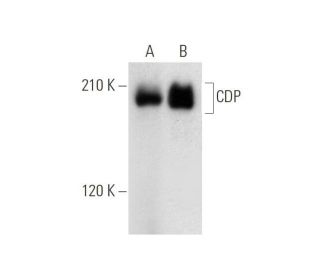
Click on image or enlarge button to enlarge
CUTL1/CUX1/CDP Antibody (B-10): sc-514008
- CUTL1/CUX1/CDP Antibody (B-10) is a mouse monoclonal IgG3 κ CUTL1/CUX1/CDP antibody, cited in 19 publications, provided at 200 µg/ml
- specific for an epitope mapping between amino acids 1308-1332 at the C-terminus of CDP of mouse origin
- recommended for detection of CDP of mouse, rat and human origin by WB, IP, IF, IHC(P) and ELISA
- available conjugated to agarose for IP; HRP for WB, IHC(P) and ELISA; phycoerythrin, FITC, Alexa Fluor® 488 or Alexa Fluor® 647 for IF, IHC(P) and FCM
- TransCruz reagent for ChIP application (sc-514008 X, 200 µg/0.1 ml)
- Contact our Technical Service Department (or your local Distributor) for more information on how to receive a FREE 10 µg sample of CUTL1/CUX1/CDP (B-10): sc-514008.
- m-IgG3 BP-HRP is the preferred secondary detection reagent for CUTL1/CUX1/CDP Antibody (B-10) for WB and IHC(P) applications. This reagent is now offered in a bundle with CUTL1/CUX1/CDP Antibody (B-10) (see ordering information below).
QUICK LINKS
SEE ALSO...
CDP Antibody (B-10) is an IgG3 κ mouse monoclonal CDP antibody (also designated CUX1 antibody, or CUTL1 antibody) that detects the CDP protein of mouse, rat and human origin by WB, IP, IF, IHC(P) and ELISA. CDP Antibody (B-10) is available as both the non-conjugated anti-CDP antibody form, as well as multiple conjugated forms of anti-CDP antibody, including agarose, HRP, PE, FITC and multiple Alexa Fluor® conjugates. CDP (for CCAAT displacement protein) has been identified as a repressor for transcription of developmentally regulated genes. It is a homeodomain protein that appears to compete with transcriptional activating proteins for binding to the promoter regions of various genes. CDP contains three cut repeats which function as DNA binding domains. It has been demonstrated that cut repeat domains have the capacity to bind to DNA in conjunction with or independently of homeodomain DNA binding. CDP has been shown to be the DNA-binding subunit of the HiNF-D complex, which contains cyclin A, Cdc2 and an Rb-related protein, in addition to CDP. Histone expression is required for the transition to S phase in the cell cycle. The HiNF-D complex regulates the transcription of histone H4, H3 and H1 genes, allowing cells to progress from G1 to S phase.
Alexa Fluor® is a trademark of Molecular Probes Inc., OR., USA
LI-COR® and Odyssey® are registered trademarks of LI-COR Biosciences
References:
- Human CCAAT displacement protein is homologous to the Drosophila homeoprotein, cut. | Neufeld, EJ., et al. 1992. Nat Genet. 1: 50-5. PMID: 1301999
- Antagonistic regulation of the Drosophila PCNA gene promoter by DREF and Cut. | Seto, H., et al. 2006. Genes Cells. 11: 499-512. PMID: 16629902
- Differentiation-induced cleavage of Cutl1/CDP generates a novel dominant-negative isoform that regulates mammary gene expression. | Maitra, U., et al. 2006. Mol Cell Biol. 26: 7466-78. PMID: 17015474
- Transgenic mice expressing the p75 CCAAT-displacement protein/Cut homeobox isoform develop a myeloproliferative disease-like myeloid leukemia. | Cadieux, C., et al. 2006. Cancer Res. 66: 9492-501. PMID: 17018605
- Conserved cut repeats in the human cut homeodomain protein function as DNA binding domains. | Harada, R., et al. 1994. J Biol Chem. 269: 2062-7. PMID: 7904999
- The mouse homeodomain protein Phox2 regulates Ncam promoter activity in concert with Cux/CDP and is a putative determinant of neurotransmitter phenotype. | Valarchε, I., et al. 1993. Development. 119: 881-96. PMID: 7910552
- CCAAT displacement protein competes with multiple transcriptional activators for binding to four sites in the proximal gp91phox promoter. | Luo, W. and Skalnik, DG. 1996. J Biol Chem. 271: 18203-10. PMID: 8663528
- CDP/cut is the DNA-binding subunit of histone gene transcription factor HiNF-D: a mechanism for gene regulation at the G1/S phase cell cycle transition point independent of transcription factor E2F. | van Wijnen, AJ., et al. 1996. Proc Natl Acad Sci U S A. 93: 11516-21. PMID: 8876167
Ordering Information
| Product Name | Catalog # | UNIT | Price | Qty | FAVORITES | |
CUTL1/CUX1/CDP Antibody (B-10) | sc-514008 | 200 µg/ml | $310.00 | |||
CUTL1/CUX1/CDP Antibody (B-10): m-IgG3 BP-HRP Bundle | sc-550607 | 200 µg Ab; 40 µg BP | $348.00 | |||
CUTL1/CUX1/CDP Antibody (B-10) AC | sc-514008 AC | 500 µg/ml, 25% agarose | $408.00 | |||
CUTL1/CUX1/CDP Antibody (B-10) Alexa Fluor® 488 | sc-514008 AF488 | 200 µg/ml | $350.00 | |||
CUTL1/CUX1/CDP Antibody (B-10) Alexa Fluor® 647 | sc-514008 AF647 | 200 µg/ml | $350.00 | |||
CUTL1/CUX1/CDP Antibody (B-10) FITC | sc-514008 FITC | 200 µg/ml | $324.00 | |||
CUTL1/CUX1/CDP Antibody (B-10) HRP | sc-514008 HRP | 200 µg/ml | $310.00 | |||
CUTL1/CUX1/CDP (B-10) Neutralizing Peptide | sc-514008 P | 100 µg/0.5 ml | $67.00 | |||
CUTL1/CUX1/CDP Antibody (B-10) PE | sc-514008 PE | 200 µg/ml | $337.00 | |||
CUTL1/CUX1/CDP Antibody (B-10) X | sc-514008 X | 200 µg/0.1 ml | $310.00 |